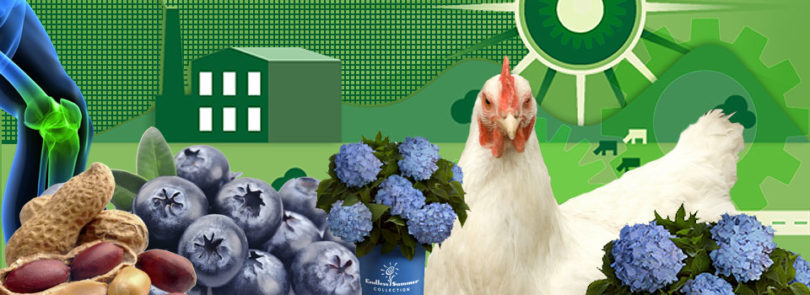Over the last 35 years, more than 500 new products based on UGA discoveries have entered the marketplace. In 2013 alone, more than 40 new products ranging from peanuts and hydrangeas to biotech tools and educational software became available. And many of these inventions-particularly in the agricultural arena-have provided a hefty economic benefit to the state of Georgia.
Take peanuts. UGA-improved peanut cultivars accounted for roughly 95 percent of the state’s estimated $890 million peanut crop in 2012, thus supporting Georgia’s No. 1 position in U.S. peanut production.
Or blueberries. Georgia is now also a major blueberry producer with a crop value of $255 million in 2011. UGA-improved varieties accounted for 55 percent of the blueberries harvested in the state that same year.
Or poultry. Poultry vaccines, developed by UGA researchers in collaboration with company partners, protect one of the state’s most important industries. Georgia’s poultry industry, which has an estimated economic impact of $28 billion, contributes more than 100,000 jobs to the Georgia economy.
These major impacts on Georgia’s agricultural sector are reflected in UGA’s top 10 technologies for 2013, which in addition to peanut cultivars includes a turfgrass (TifSport), wheat and soybean cultivars, and a hydrangea cultivar called Endless Summer.
But the top 10 product list isn’t limited to agricultural products. It also includes pharmaceuticals, research tools, diagnostics and other vaccines, as well as ornamental plants.
“As a comprehensive land grant university, UGA’s diverse research program is reflected in the broad range of technologies licensed to industry partners,” said Derek Eberhart, director of UGA’s Technology Commercialization Office in the Office of the Vice President for Research. And he anticipates even more breadth in UGA’s intellectual property portfolio with the rapid expansion of UGA’s new College of Engineering.
UGA first began licensing university inventions to industry for develop¬ment into commercial products, and consequent¬ly for public benefit, in the late 1970s. The licensing revenue is distributed to the inventor, the inventor’s research program and department, with well more than half invested back into the UGA research program to fund promising new research. UGA’s licensing program has grown dramatically over the past 35 years, from less than $6 million in licensing revenue during the first 15 years to $137 million in the most recent 10-year period.
UGA’s Technology Commercialization Office is consistently ranked among the top technology transfer offices in the country. In 2012, it ranked among the top five U.S. universities for license/option agreements executed for the sixth consecutive year and among the top 15 public universities in licensing revenue.
“We are proud of this commercialization record but certainly not content. We’ll keep assessing, improving and reinventing the ways in which we move UGA discoveries into the market. This is one of the important ways in which we contribute to economic development in the state.”
Successful products based on UGA discoveries include:
- The Bradford Assay (1978): The Bradford Assay, a classic tool in the molecular biology field for measuring protein content, was UGA’s first major commercial product. It remains an essential tool for researchers today.
- Poultry vaccines (1990-92): Cholervac PM, PM-ONEVAX and Avinew protect one of Georgia’s most important economic industries.
- Aequorin and Renilla Luciferase (1992): Basic genetic research at UGA on bioluminescence (production of light by a living organism) in jellyfish and the sea pansy led to the development of molecular biology tools researchers can use to assess biological processes, such as the development of nerve cells in the brain or how cancer cells spread.
- Peanuts (1993-present): Georgia Runner, Green and 06G are among 19 elite peanut cultivars developed at UGA. In 2012, UGA cultivars accounted for about 95 percent of the state’s estimated $890 million peanut crop value.
- Optimmune (1995): A UGA veterinarian developed a prescription drug to treat chronic dry-eye in dogs.
- TifSport, TifEagle, TifBlair turfgrasses (1999-2002): The TeamUGA Turfgrass Breeding Program continues to develop superior turfgrass cultivars with increased tolerance to drought, disease, cold, shade and saltwater. In Georgia alone, the annual farm gate value of turfgrass exceeds $75 million.
- The Glass Horse (2002): An interactive program helps horse owners and veterinarians understand the anatomy of the equine gastrointestinal tract. The Glass Horse concept now extends to other parts of horse anatomy and dogs.
- Restasis (2004): The active ingredient in Optimmune, initially developed for veterinary use, was found to be effective for relieving chronic dry-eye in humans, too. Dry-eye affects an estimated 1 million people in the U.S. and can lead to serious cornea damage. The prescription drug Restasis became a blockbuster treatment marketed in more than 35 countries, earning more than $60 million for University of Georgia research.
- Endless Summer Hydrangea (2004): A UGA plant breeder discovered a new genetic trait in hydrangeas allowing multiple periods of blooming throughout the growing season. Incorporation of this trait in the Endless Summer line of hydrangeas helped UGA varieties account for more than half of the total U.S. farm gate value of $30 million in 2012.
- Blueberries (2006-2007): Since 2001, the UGA Blueberry Breeding Program has introduced 13 patented cultivars and helped Georgia become the No. 1 state in acres of blueberries, surpassing peaches as the state’s No. 1 fruit crop. UGA cultivars account for more than 50 percent of the blueberries grown in Georgia and are grown on all continents except Antarctica.
- hNP1 (2006-2007): UGA researchers developed technology allowing the production of neural cells derived from stem cells. These cells, commercialized by UGA startup company ArunA Biomedical, provide a unique platform for conducting biomedical research to help understand the causes of, and discover new drugs to treat, neurological disorders, such as Parkinson’s and Alzheimer’s.
- HatchPak Cocci (2009): Developed in partnership with Merial, this vaccine adds to the arsenal of vaccines developed by UGA’s poultry research program to help protect Georgia’s $28 billion poultry industry.
- Biology Bytes (2013): A team of UGA researchers developed a gaming software platform to help high school students understand challenging scientific concepts. UGA startup company IS3D licensed the technology and has launched products such as Osy Osmosis and Biology Bytes.
- Revalife (2013): Revalife, an anti-inflammatory topical cream incorporating patented UGA technology, promotes joint health. It was launched recently by International Nutraceutical Co. of America LLC.








